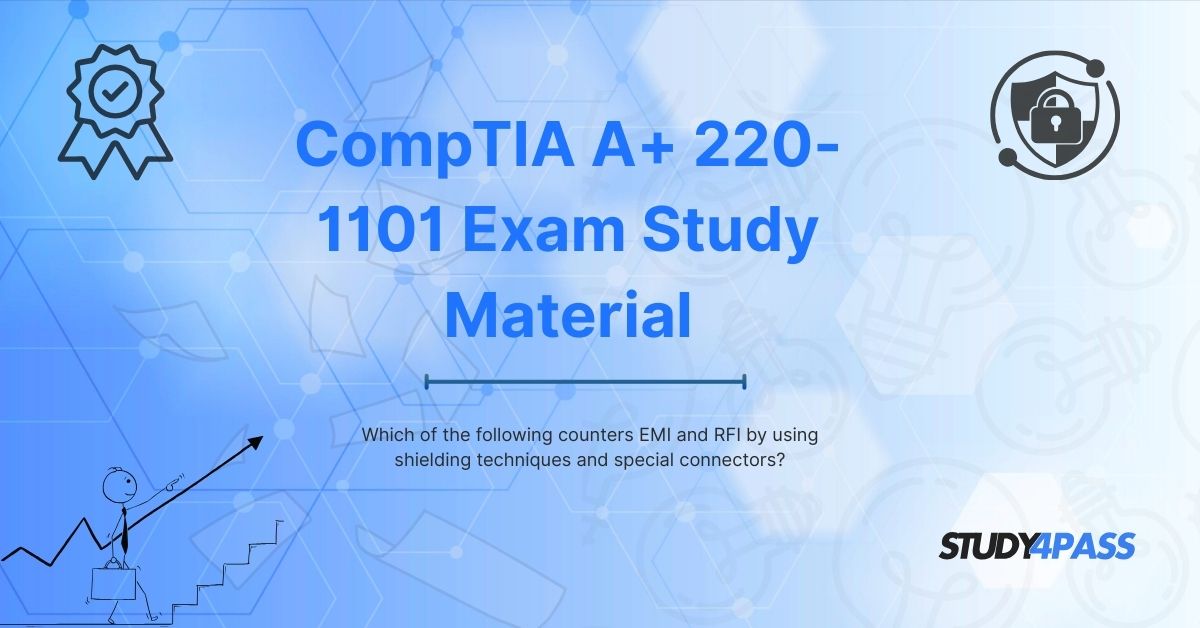Introduction
Electromagnetic Interference (EMI) and Radio Frequency Interference (RFI) are common challenges in modern electronic systems. These interferences can disrupt signal integrity, reduce performance, and even cause system failures. To mitigate these issues, shielding techniques and specialized connectors are used. This article explores the different counters for EMI and RFI, focusing on shielding methods and connectors, as part of the CompTIA A+ 220-1101 certification study material.
For comprehensive A+ certification study guides, practice tests, and expert resources, visit Study4Pass a trusted platform for IT certification preparation.
Understanding EMI and RFI
What is EMI?
Electromagnetic Interference (EMI) refers to disturbances caused by electromagnetic radiation from external sources, affecting electronic circuits. EMI can be:
- Conducted EMI – Travels through wires and cables.
- Radiated EMI – Propagates through the air as electromagnetic waves.
What is RFI?
Radio Frequency Interference (RFI) is a subset of EMI, specifically caused by radio frequency signals. Common sources include:
- Wireless devices (Wi-Fi, Bluetooth)
- Radio transmitters
- Mobile phones
Both EMI and RFI can degrade signal quality, leading to data corruption, slower network speeds, and hardware malfunctions.
Counters for EMI and RFI: Shielding Techniques
Shielding is the primary method to block or reduce EMI/RFI. Different materials and techniques are used depending on the application.
1. Metallic Shielding
Metals like copper, aluminum, and steel are commonly used for shielding due to their conductive properties.
- Faraday Cages: Enclosures made of conductive materials that block external electromagnetic fields.
- Shielded Cables: Cables with a metallic foil or braided mesh to prevent interference.
2. Conductive Coatings
- Conductive Paints: Applied to plastic enclosures to provide EMI shielding.
- Nickel or Silver Coatings: Used in high-frequency applications.
3. Ferrite Beads and Chokes
- Ferrite Beads: Placed around cables to suppress high-frequency noise.
- Common Mode Chokes: Reduce common-mode interference in data lines.
4. Grounding Techniques
Proper grounding ensures unwanted EMI is dissipated safely.
- Single-Point Grounding: Used in low-frequency circuits.
- Multi-Point Grounding: Suitable for high-frequency systems.
Special Connectors to Counter EMI and RFI
Connectors play a crucial role in maintaining signal integrity. Specialized connectors are designed to minimize interference.
1. Shielded RJ45 Connectors
- Used in Ethernet cables to prevent crosstalk and external interference.
- Features a metal shield around the connector.
2. BNC Connectors (Bayonet Neill-Concelman)
- Commonly used in coaxial cables for video and RF applications.
- Provides strong EMI/RFI shielding.
3. USB and HDMI with Ferrite Cores
- Ferrite cores are added to USB/HDMI cables to suppress high-frequency noise.
4. D-Subminiature (DB) Connectors with Metal Hoods
- Used in serial and VGA connections.
- Metal hoods provide additional shielding.
5. Fiber Optic Connectors
- Immune to EMI/RFI since they transmit light instead of electrical signals.
- Ideal for high-noise environments.
Applications of EMI/RFI Shielding in IT Systems
1. Computer Hardware
- Motherboards: Use shielded traces to prevent interference.
- Power Supplies: Enclosed in metal casings to block EMI.
2. Networking Equipment
- Switches and Routers: Use shielded RJ45 ports.
- Wi-Fi Antennas: Positioned to minimize RFI.
3. Medical and Military Devices
- Require high-level shielding for sensitive operations.
Study4Pass - Your Best Resource for CompTIA A+ 220-1101 Preparation
Preparing for the CompTIA A+ 220-1101 exam requires reliable study materials. Study4Pass offers:
Comprehensive Study Guides
- Practice Tests with Real Exam Questions
- Interactive Learning Modules
- Expert Tips and Video Tutorials
Boost your IT career with Study4Pass the ultimate platform for A+ certification success!
Conclusion
EMI and RFI can significantly impact electronic systems, but proper shielding techniques and specialized connectors help mitigate these issues. Understanding these concepts is crucial for the CompTIA A+ 220-1101 exam. For top-notch study resources, visit Study4Pass and ace your certification with confidence!
Special Discount: Offer Valid For Limited Time “220-1101 Exam Material”
Actual Exam Questions For CompTIA's 220-1101 Certification
Sample Questions For CompTIA 220-1101 Practice Test
1. Which of the following is used to counter EMI and RFI in electronic systems?
a) Fiber-optic cables
b) Unshielded twisted pair (UTP) cables
c) Shielding techniques and special connectors
d) Plastic casings without grounding
2. What is the primary purpose of shielding in electronic devices?
a) To improve data transmission speed
b) To reduce electromagnetic and radio frequency interference (EMI/RFI)
c) To increase power consumption
d) To enhance wireless signal strength
3. Which type of connector is commonly used to minimize EMI and RFI?
a) RJ45 connectors
b) USB Type-A connectors
c) Shielded D-sub or MIL-spec circular connectors
d) Bare copper wire connectors
4. How does shielding in cables help in reducing interference?
a) By increasing signal voltage
b) By blocking external electromagnetic waves using conductive materials
c) By reducing cable length
d) By converting analog signals to digital
5. Which material is commonly used for EMI/RFI shielding?
a) Plastic
b) Wood
c) Copper or aluminum foil
d) Glass


